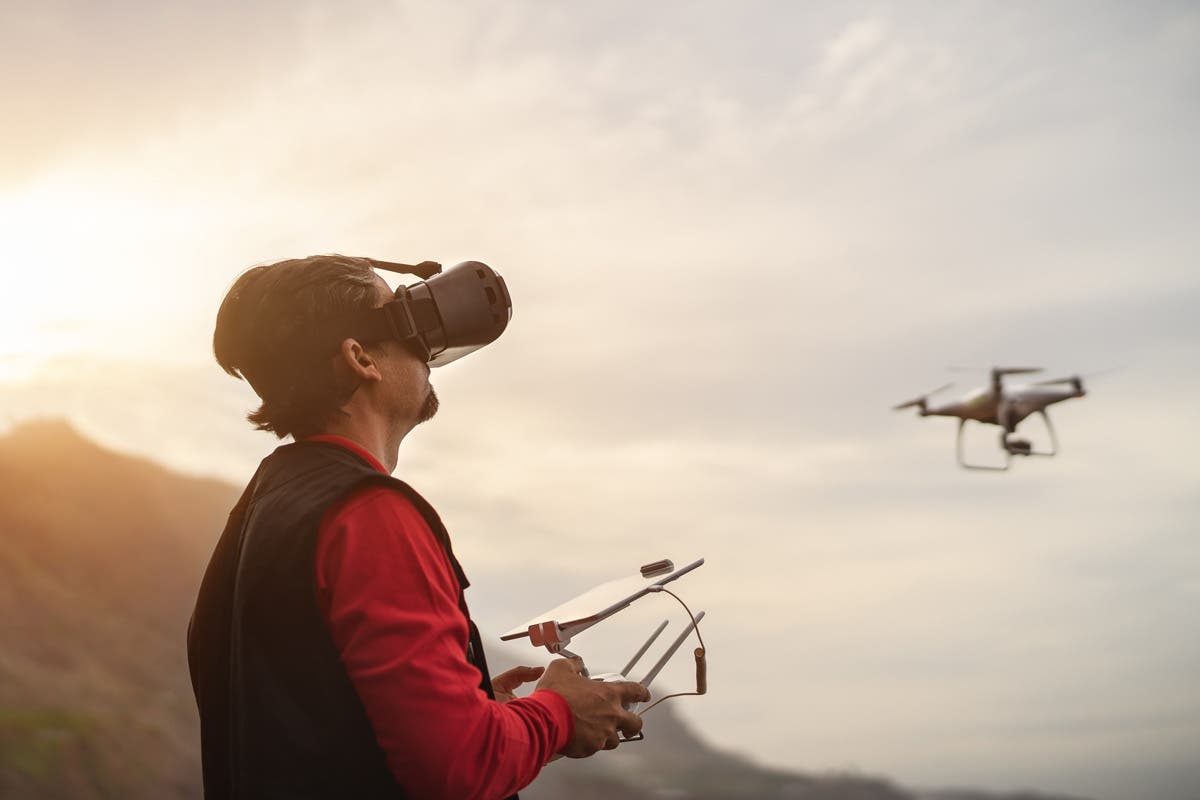Most people are familiar with the small drones that zoom around the local park. However, a new wave of first-person view (FPV) technology has arrived, and it delivers a game-changing experience for drone pilots.
These devices blend the best technology from drones and virtual reality to serve up an exciting first-person flying feel. This is a groundbreaking innovation, and it provides the sort of thrill usually reserved for fighter pilots.
What is an FPV Drone?
An FPV drone typically comes with a high-tech headset that looks like the sort of VR unit that you’d use with a gaming PC or console. For a more affordable option, you can slot your smartphone into a headset adapter unit.
The FPV goggles display the video feed from a camera, and you then use that view to steer the drone. By using the FPV camera, this is basically as close as you can get to flying without leaving the ground.

How an FPV Drone works
An FPV system has several key parts. The FPV drone itself is usually a small, maneuverable multi-rotor model with precise control, hovering, and vertical take-off. On the drone body, you’ll find a camera and a video transmitter.
The cameras range from basic models to more expensive 1080p and 4K options. A high-quality transmitter ensures a reliable live-video signal with low latency, which means there’s little time lag between what the camera sees and what you see on the ground.
At ground-level, these systems rely on FPV goggles and a remote controller. The goggles include a headset with a screen that captures the first-person view. The flight controller often looks like a video game pad and is used for FPV drone flying.
Who uses FPV drones?
FPV flying serves up an incredible real-time experience, and the perspective has several big advantages. You get more precision, which is crucial for racing drones, and a cinematic perspective that you don’t get from the ground. Plus, it’s just a lot of fun.
Photographers and videographers take advantage of FPV’s immersive, exciting experience to capture shots they’d never be able to get from terra firma. Other enthusiasts use these maneuverable machines for drone racing, and hobbyists use FPV hardware for freestyle flying. The first-person view makes it easier to perform stunts and zoom through tricky environments just like you see in national drone races on TV.
FPV drones have even been deployed successfully in search-and-rescue operations and on farms for more accurate crop-spraying. Insurance claims adjusters use them, too, as a way to assess storm damage without relying on labor-intensive ground investigation.

Should you build or buy an FPV drone?
There are plenty of FPV drone kits available right now from big companies like DJI and 4DRC. Buy one, charge the drone, and slip the headset on, and you’ll be piloting your drone in no time.
While FPV drone kits make it easy to get started, many enthusiasts prefer to build their own. By constructing your own unit, you can choose each individual component, or save money by sticking to a certain budget. It’s also easier to repair your own hardware once you’ve learned to build your kit.
New drone pilots tend to crash their devices more frequently when they’re learning to fly. A drone that’s easier and less expensive to repair can help keep you in the air.
Should you buy an FPV drone?
The first-person view of an FPV system provides a sensational flying experience, but there are pros and cons.
On the plus side, FPV hardware is outstanding for stunts, freestyle flying, racing, and aerial photography. If you’re interested in any of those applications, an FPV drone is a great choice.
However, wearing a headset isn’t the most comfortable or versatile option for working on other ground-based tasks. Also, the added difficulty of flying FPV devices means they’re not ideal for beginners. Finally, for flying outdoors, you may need a helper to act as a spotter for obstacles. That makes these drones less attractive for solo FPV pilots.
Adorama carries a complete selection of FPV drones by Force 1, DJI, and Vifly.
What accessories are available for FPV drones?
There are a wide variety of accessories available for FPV (First Person View) drones, which are designed to enhance the flying experience, improve performance, and increase safety. Some of the most common accessories include:
- FPV Goggles: These are specialized goggles that allow you to see the drone’s live video feed in real-time, providing an immersive and thrilling flying experience. An example of this is the DJI Goggles Integra.
- Transmitter/Controller: A high-quality transmitter or controller is essential for controlling the drone accurately and ensuring a stable connection. An example of this is the DJI RC Motion 2 Controller.
- Batteries: FPV drones require high-performance batteries that provide enough power and endurance for extended flights. Some popular battery types include LiPo, LiHV, and NiMH.
- Propellers: Upgraded propellers can improve the drone’s overall performance, speed, and agility.
- Antennas: High-gain antennas can improve the drone’s signal range and video quality, allowing you to fly further and capture better footage.
- Camera Mounts: These are designed to help stabilize the camera and reduce vibrations, resulting in smoother footage and clearer images.
- GPS Modules: GPS modules can provide accurate location data, allowing you to track the drone’s flight path and even program it to fly to specific locations.
- Carrying Cases: A carrying case can help protect your drone during transport and storage, keeping it safe from damage.
Feature image via Shutterstock






